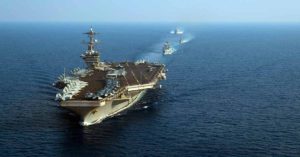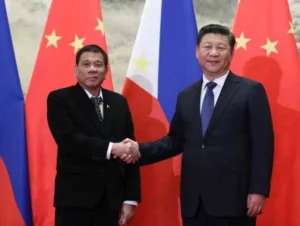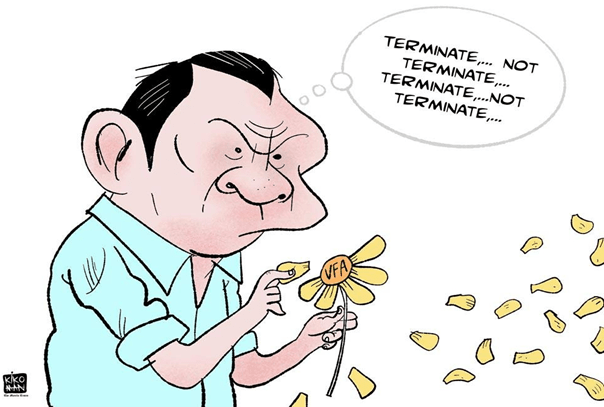
The bilateral relations between the United States (US) and the Philippines are currently at a critical juncture. This is because of the latest tirades of President Rodrigo Duterte telling the Americans that the Visiting Forces Agreement (VFA) between the US and the Philippines is a “shared responsibility,” therefore, the US must pay or kiss it goodbye.
The VFA signed in 1998, which came into effect in 1999 was the first military agreement since the closing of US bases in 1992.
In his recent weekly address to the nation, Duterte reiterated that the US should give the Philippines something in return, especially since the latter is the “nearest, possible and convenient outpost of the US.
“You want the Visiting Forces Agreement done? Well, you have to pay. It’s a shared responsibility. But your share of responsibility does not come free because after all when the war breaks out, we all pay. We’re nearest to the garrison there, a lot of arsenals of the Chinese armed force. I hope that the Americans would take notice of that.”
He also contended that the US government has failed to deliver on some of its previous promises to the Philippines.
These statements from the maverick president have not only placed uncertainty on the future of the US-Philippines strategic alliance, but also garnered all sorts of reactions from Filipinos.
Reactions
Among the political personalities who have misunderstood where Duterte is coming from and the intentions behind his latest remarks concerning the VFA include Vice President Leni Robredo and Senator Panfilo Lacson. These politicians have interpreted Duterte’s latest tirades against the VFA as “embarrassing” and akin to “extorting money from its long-time ally,” – the US.
However, there are also political personalities who have expressed a more supportive stance and understand where Duterte is coming from and why he made those statements about the VFA.
Foreign Affairs Secretary Teodoro Locsin Jr. on 16 February pointed out that Manila has a right to “expect some measure of lethal parity” in its Mutual Defense Treaty (MDT) with the US. The MDT between the Philippines and the US refers to a pledge by both countries to defend each other’s territory in the case of external attack or aggression. The treaty was signed on 30 August, 1951.
Senator Juan Miguel Zubiri was also in agreement and expressed that, “I think in a way, we’re always getting the short end of the stick in getting assistance from our friends in the USA.”
While Congressman Alan Peter Cayetano urged the public to trust Duterte’s handling of the VFA with the US. In a media interview, Cayetano said Duterte has the best interests of the Philippines at heart when he said that the US government must pay for the continuation of the agreement.
Context
Amid the various reactions among Filipinos concerning the latest bluster from Duterte about the VFA, it is important to understand the context and to shed light on why Duterte has been exasperated and riled-up by the Americans.
This is not the first time Duterte has challenged the status quo of the 22-year-old VFA. On 11 February, 2020, the Philippine government officially notified the US that it would be terminating the VFA. This was in response to an accumulation of unwanted interferences from the US in the domestic affairs of the Philippines, including a horde of “disrespectful acts” by some US senators directed against the sovereignty of the country.
The termination of the VFA came after the cancellation of Senator Ronald “Bato” Dela Rosa’s US visa following an amendment to the US 2020 budget, which had authorised by then US Secretary of State Mike Pompeo to bar Philippine government officials involved in Senator Leila de Lima’s illegal drug-related charges from entering the US.
Apart from the amendment to the US budget, the American senators also passed Senate Resolution 142, asking US President Donald Trump to impose sanctions on Philippine government officials allegedly behind de Lima’s detention.
As a response to the travel ban imposed by the US at the time, Duterte ordered his cabinet officials to “boycott” Washington. Duterte also rejected Trump’s invitation to attend the Southeast Asian Leaders’ Summit in Las Vegas, Nevada on 4 March, 2020. However, just a few months after, the President decided to temporarily suspend the abrogation of the 22-year-old VFA due to the coronavirus pandemic.
A few months ago, Duterte once again harked-back at the Americans telling them that he will abrogate the VFA if they are not serious about their commitments with the Philippines concerning the delivery of Covid-19 vaccines.
“The VFA is nearing its end. If they fail to deliver even a minimum of 20 million vaccines, they better get out. No vaccine, no stay here,” Duterte said. He also further reiterated that “If you want to help, if America wants to help, you deliver. Stop talking. What we need is the vaccine, not your verbose speeches.”
Indeed, the fate of the VFA is “hanging by a thread” and its survival or demise depends on how serious the US is in delivering its part of the bargain.
Hindsight And Perspective
To put things into perspective, the demands of President Duterte for compensation from the US is long overdue and a step in the right direction. Moreover, this is not the first time that a Philippine president has demanded compensation for the presence of military troops and equipment in the country. Even the late President Ferdinand Marcos made similar demands during his administration.
In an interview on the CBS program “Face the Nation,” in 1986, Marcos asserted that Washington had failed to live up to its end of a 1983 bargain that promised US$900 million in US military and economic aid over years while ensuring American use of the strategic Subic Bay Naval Base and Clark Air Base on the main island of Luzon through 1991.
Specifically, Marcos complained that, in implementing the bases accord, the US had so far shorted his country by about US$70 million in promised military aid.
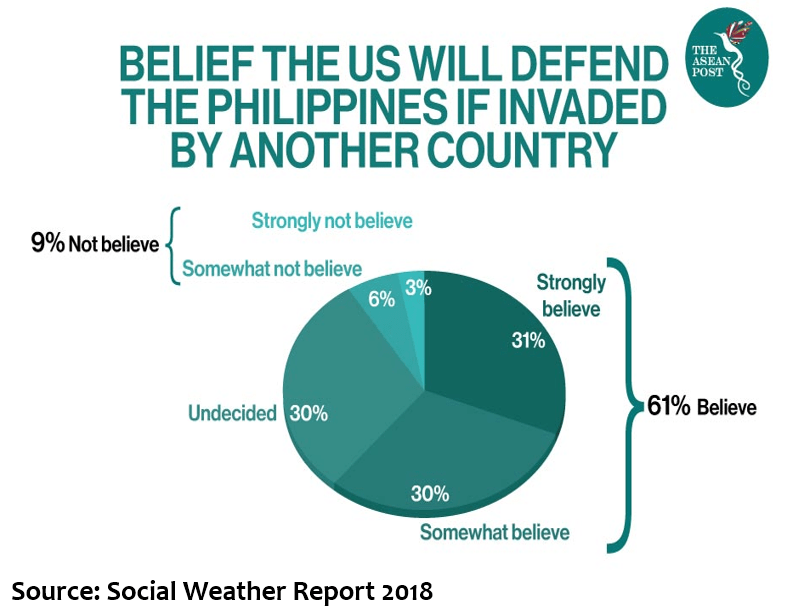
The VFA is not primarily for the security of the Philippines rather it is to project and promote US strategic interests in the Philippines and in the Indo-Pacific region more specifically in the disputed waters of the South China Sea (SCS). This can be substantiated by the location of some of the US forces and equipment in the country in Basa Air Base, Fort Magsaysay, Antonio Bautista Air Base, Mactan-Benito Ebuen Air Base, and Lumbia Air Base which are strategically located to serve US strategic security interests and purposes.
Some of these military bases are located near the disputed waters of the SCS, which substantially boost the US’ military ability to challenge Beijing while putting the Philippines in a precarious situation if in any case a military confrontation between the two superpowers happens.
Given the “cold war” atmosphere between the two superpowers at the moment, if a “hot war” were to break-out, China would target the Philippines because of the presence of US military forces and equipment in the country.
In this regard, it is justified that the Philippine government demands some form of compensation for the Filipino people.
In April 2015, the US asked for access to eight bases in the Philippines including the formerly American Subic Bay Naval Base and Clark Air Base as well as bases in Cebu, Luzon, and Palawan. On 19 March, 2016 the Philippines and the US agreed on the location of five military bases for American troops under the Enhanced Defense Cooperation Agreement (EDCA). These include the Mactan Cebu (Benito Ebuen Air Base); in Palawan (Antonio Bautista Air Base); in Pampanga (Basa Air Base); in Nueva Ecija (Fort Magsaysay); and Cagayan de Oro (Lumbia Airport).
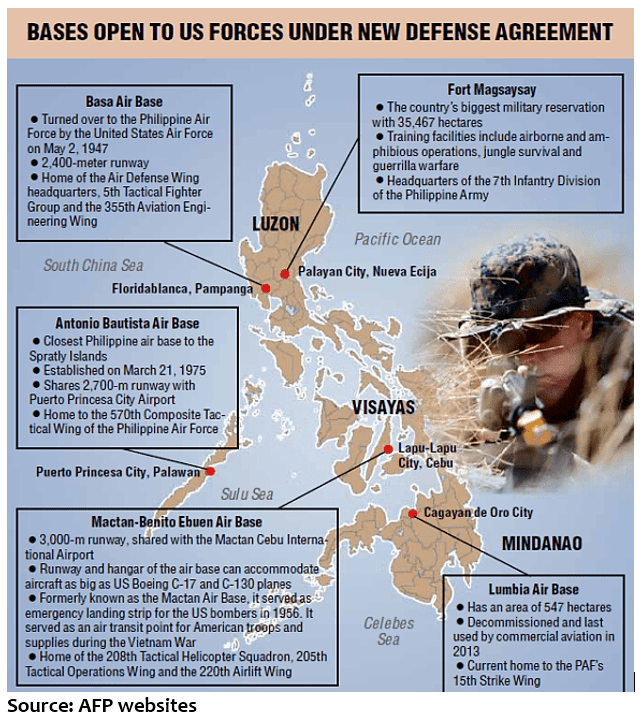
The EDCA is an agreement between the US and the Philippines that allows the US to rotate troops in the Philippines for extended stays and allows the US to build and operate facilities on Philippine military bases for both, American and Filipino forces though not permanently, but realities say otherwise.
The EDCA is a supplemental agreement to the VFA. It allows US forces to preposition and store defense material, equipment, and supplies with the exclusion of nuclear weapons.
Conclusion
In retrospect, no Philippine president has challenged the status quo surrounding the VFA and the MDT until Rodrigo Duterte, who more often than not, has defied the US in terms of how the country handles its domestic affairs and even its foreign policy in relations to the US and the rest of the world while asserting its independence and sovereignty.
Duterte refuses to be intimidated and undermined and is standing up to protect the country’s national security and to promote its interests.
The VFA, MDT, and EDCA are very much connected to Philippine sovereignty and independence. Adequate compensation, and the costs and benefits of having a US military presence in the country are issues very much intertwined with the country’s national security and interests.
President Duterte would want the Philippines to have more leverage and advantage given the existing geopolitical realities where the US-China rivalry for dominance and influence in the Indo-Pacific region, especially in the disputed waters of the SCS, has unwittingly dragged the Philippine into the equation because of its strategic location.
Likewise, the Philippines is in a position to demand compensation from the US because it has been an ally for more than a century, as well as a major non-NATO (North Atlantic Treaty Organization) ally, that is quite important to America’s defense/military strategy in the Indo-Pacific.
Thus, it should renegotiate the VFA with the US from a position of strength and that’s what Duterte is trying to do at the moment. However, if in any case, the Duterte administration is unable to renegotiate a more balanced deal on the VFA and if the US refuses to extend compensation, then it is better for Duterte to just abrogate the VFA.
Source: Sovereign PH
https://sovereignph.com/2021/06/21/visiting-forces-agreement-abrogation-or-negotiation/

